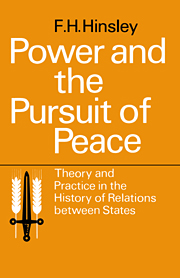Book contents
- Frontmatter
- Contents
- INTRODUCTION
- PART I A HISTORY OF INTERNATIONALIST THEORIES
- PART II A HISTORY OF THE MODERN STATES' SYSTEM TO 1900
- PART III INTERNATIONAL RELATIONS AND INTERNATIONAL ORGANIZATIONS IN THE TWENTIETH CENTURY
- 12 International Relations in the First Half of the Twentieth Century
- 13 The First World War
- 14 The Failure of the League of Nations
- 15 The Causes of the Second World War
- 16 The Nature and Development of the United Nations
- 17 International Relations since the Second World War
- References
- Index
16 - The Nature and Development of the United Nations
Published online by Cambridge University Press: 11 January 2010
- Frontmatter
- Contents
- INTRODUCTION
- PART I A HISTORY OF INTERNATIONALIST THEORIES
- PART II A HISTORY OF THE MODERN STATES' SYSTEM TO 1900
- PART III INTERNATIONAL RELATIONS AND INTERNATIONAL ORGANIZATIONS IN THE TWENTIETH CENTURY
- 12 International Relations in the First Half of the Twentieth Century
- 13 The First World War
- 14 The Failure of the League of Nations
- 15 The Causes of the Second World War
- 16 The Nature and Development of the United Nations
- 17 International Relations since the Second World War
- References
- Index
Summary
‘We must realise’, concluded an eminent international lawyer in 1946, ‘that what we have done is to exchange a system which might or might not have worked for one which cannot work, and that instead of limiting the sovereignty of states we have actually extended the sovereignty of the Great Powers, the only states whose sovereignty is still a formidable reality in the modern world.’ Judged from the point of view of international history, as opposed to that of international law, this verdict is unacceptable so far as it concerns the League of Nations: the League could not have worked. Is it true from this point of view in relation to the United Nations, the international organisation which was set up after the second World War as the League had been set up after the first?
The conclusion was based on an analysis of the differences between the Charter of the United Nations and the Covenant of the League. The most obvious of these differences does not at first sight support it. The United Nations structure, unlike the League, was set up as an organisation that was more than the sum of its parts―with organs of its own, with an identity distinct from that of its members and with functions independent of those of its members.
- Type
- Chapter
- Information
- Power and the Pursuit of Peace: Theory and Practice in the History of Relations Between States , pp. 335 - 345Publisher: Cambridge University PressPrint publication year: 1962



